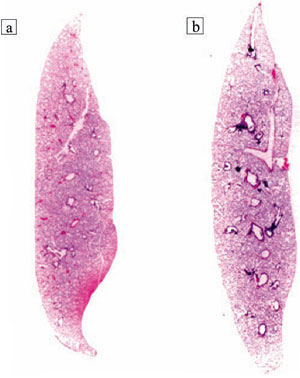| Posted: Jul 25, 2006 | |
A first report on the biocompatibility of nitrogen-doped carbon nanotubes |
|
| (Nanowerk Spotlight) A new toxicological study of carbon nanotubes (CNTs) doped with nitrogen found clear differences in the toxicological aspects and biocompatibility compared to multiwalled or singlewalled CNTs, indicating that they might be more advantageous for bioapplications. | |
| Scientists and toxicologists have not reached any consensus yet on the level of toxicity of CNTs although there are indications that under certain circumstances they might be hazardous. However, if CNTs are to be used in novel products, then they are likely to get in contact with the human body through the skin and access the inner organs through the respiratory and digestive tracts. During manufacture, carbon nanotubes may enter the respiratory airways of the workers, and accumulate in the lungs. If nanotubes are used as fillers in food packaging products, then they could reach the stomach and intestines of the consumers. If cosmetics and bio-filters are developed using nanotubes, then they will certainly get in contact with human skin. | |
| This is the reason why a number of researchers have taken up toxicological studies of CNTs. One of them is Professor Mauricio Terrones from the Advanced Materials Department at IPICyT in Mexico. He explained his recent study's findings to Nanowerk: | |
| "In general we found that nanotubes (pure carbon multiwalled and N-doped multiwalled) are not harmful if they are ingested or inhaled by mice. However when the CNTs are introduced intratracheally into the mice, our N-doped nanotubes are far more tolerated and did not cause the death of any mouse. Even extremely high concentrations of N-doped nanotubes administrated directly into the mice’s trachea only induced granulomatous inflammatory responses. In contrast, pure multiwalled CNTs caused the death of the mice when treated intratracheally at high doses." | |
 | |
| Progressive pulmonary lesions caused by intratracheal instillation of N-doped MWNTs to mice. The panels show hematoxylin- and eosin-stained lung sections from mice treated with N-doped MWNTs at 1 mg/kg after 24 h (a) and 5 mg/kg after 24 h (b). Original magnifications were taken at 2X. (Reprinted with permission from American Chemical Society) | |
| Terrones and his colleagues from IPICyT and the Universidad Nacional Autónoma de México published their findings, titled "Biocompatibility and Toxicological Studies of Carbon Nanotubes Doped with Nitrogen" in the July 7, 2006 online edition of Nano Letters. | |
| It is important to emphasize that the present study involved only one type of N-doped CNTs containing between 2 and 4 wt %, and further studies dealing with different nitrogen concentrations are required and currently underway. Terrones and his colleagues established that N-doped CNTs are not toxic to mice when administered at doses ≤1 mg/kg; however, when high concentrations (e.g., 5 mg/kg) are directly inoculated into the trachea of mice, they result in bronchial epithelial erosion and an acute inflammatory response. | |
| "Because none of our studies with N-doped CNTs resulted in the death of the mice, we believe that N-doped CNTs would be more biocompatible when compared to other types of nanotubes (e.g., single-walled, multiwalled, double-walled, etc.), suggesting that these types of nanotubes could now be tested in biological systems such as drug and antigen delivery (immunological adyuvants) as well as infectious-agent inhibitors" says Terrones. | |
| "N-doped tubes can now be considered an efficient alternative for instance as virus inhibitors" he notes. "We are able to disperse them in water and therefore it could be possible to attach certain chemicals to CNTs to combat viruses or tumor cells." | |
| Although optimistic about potential bioapplications of N-doped CNTs in the future, Terrones is also realistic: " We need to carry out a lot more research, especially with regard to longterm effects of all types of CNTs. We are at the early stages but have very encouraging results and I do not doubt that we will have some vaccines of cancer treatments with these types of tubes!" | |
 By
Michael
Berger
– Michael is author of three books by the Royal Society of Chemistry:
Nano-Society: Pushing the Boundaries of Technology,
Nanotechnology: The Future is Tiny, and
Nanoengineering: The Skills and Tools Making Technology Invisible
Copyright ©
Nanowerk LLC
By
Michael
Berger
– Michael is author of three books by the Royal Society of Chemistry:
Nano-Society: Pushing the Boundaries of Technology,
Nanotechnology: The Future is Tiny, and
Nanoengineering: The Skills and Tools Making Technology Invisible
Copyright ©
Nanowerk LLC
|
Become a Spotlight guest author! Join our large and growing group of guest contributors. Have you just published a scientific paper or have other exciting developments to share with the nanotechnology community? Here is how to publish on nanowerk.com.
